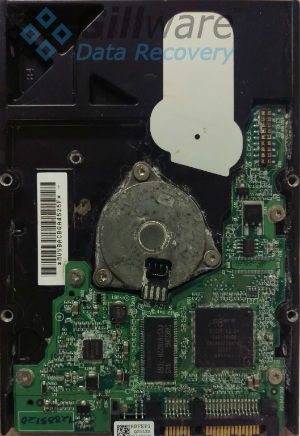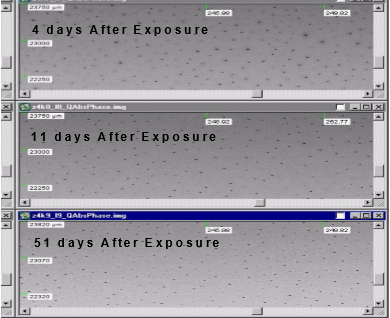Water Damaged HDDs: Recovering Your Data After a Flood
Special thanks to Ron Dennison for providing his insights in hard drive failure analysis for both this blog post and our handling guide for water damaged HDDs.
In our data recovery lab at Gillware, we’re no strangers to water damage. When we get data storage devices in our cleanroom that have suffered water damage, it can be anything from a laptop that got a glass of water spilled on it to hard drives or servers pulled out of flooded businesses and homes in the wake of natural disasters such as the recent flooding in Louisiana. Read on for Gillware’s overview on water damaged HDDs, including why water is so bad for electronics and the effects water has on the innards of your hard drives. We also have a handling guide for water damaged HDDs if you need to send a hard drive to us for data recovery.
How Water Corrodes Your Electronics
Water is a precious substance. An average human can only survive for three to five days without it. You’ve probably been told at least once in your life to drink eight glasses of it a day. And yet it’s not so healthy for your phone or computer. And this is because of simple chemical reactions.

Water is made up of two hydrogen atoms and one oxygen atom. Hydrogen and oxygen are both reactive elements. Oxygen, in particular, is a surprisingly corrosive agent. The best example of oxygen’s corrosive properties is iron oxide, also known as rust. Copper is also vulnerable to corrosion. This is how the Statue of Liberty, which is made out of copper, gained its now-characteristic mint-green coloration (when it was first unveiled, it was as shiny as a new penny). For an example of how scary too much oxygen can be, one need look no further than the horrifying and tragic Apollo 1 fire. Or, if geological history is more your thing, the charmingly-named Oxygen Catastrophe.
It goes without saying that there is a lot of metal inside electronic devices. Especially copper, which makes for a great conductor. When you submerge a phone or computer in water, you saturate its metal components with water. The ensuing chemical reactions create corrosion.
How Water Short-Circuits Your Electronics
Somewhat counter-intuitively, pure H2O (or dihydrogen monoxide) is actually a very poor conductor of electric currents. There are very few ions in pure water, and electricity loves ions. The natural impurities in water, however, are full of ions, and are very good at conducting electricity. A single drop of water in the right place on a circuit board can draw the electrical current out of its preordained path.
Imagine that you are an electrical current traveling through a circuit. Suddenly you come up against a droplet of water in your way. It’s even more inviting of a path than the copper you’re traveling through. And electricity always takes the path of least resistance. And so you escape your preordained path, take a shortcut through the water, and end up in the wrong place. Thus, you short-circuit the board.
Once a circuit board has been shorted, running power through it can burn parts of the board. Connecting a short-circuiting device to another device can also cause the other device to short out as well. For example, plugging a hard drive with a shorted board into a power supply unit could fry the PSU as well.
What Happens to Water Damaged HDDs?
Your hard drive is full of delicate parts, such as the read/write heads and platters. Unsurprisingly, water is not good for them. Not only can water corrode or short-circuit the exposed circuit board, but in extreme flooding situations it can also seep into the hard drive and wreak havoc. The internals of your hard drive can become corroded. There’s no way to reverse corrosion (although some corrosion can be cleaned off by an expert), just as you can’t un-burn firewood.
Inside your hard drive, there are read/write heads that read the data stored on the drive’s platters. These heads are tiny coils of copper wire mounted on the ends of long metal arms. Read/write heads are like tiny airplane wings, hovering mere nanometers apart from the surfaces of the drive’s platters. From their perspective, a single droplet of water is a mountain. If the read/write heads collide with even a single drop of water, it can cause a head crash and scratch the surfaces of the platters.
How Safe Are Your Water Damaged Hard Drives’ Platters?

Your hard drive’s platters are made out of either aluminum or glass. These aluminum and glass disks are coated with a thin layer of magnetic substrate, which contains your data. The substrate is made up of very thin layers of Ruthenium, cobalt-nickel-iron alloys, and cobalt-chromium-platinum alloys. The substrate actually corrodes very readily. Platters are delicate, and only a small amount of corrosion can cause data loss.
Our data recovery engineers often see rust on the platters of flood-damaged drives, not from the platters themselves, but from the screws inside the drive. Particles of rust would flake off and stick to the platters. When floods and hurricanes hit, the water that fills businesses and homes is incredibly dirty, and the dirt can actually become caked onto the platters as well.
Modern hard drives have a thin layer of lubricant on their platters. When the platters become wet, the water sticks to the lubricant. And after the water has evaporated, the lubricant will no longer be evenly coated on the platters. Instead, it will have pooled on portions of the platters, forming large bubbles on their surfaces. Our engineers can remove the pooled lubricant, but there is no way to re-apply it.
The disk lubricant is PFPE in several forms. Typically a mixture of both end chain surface-bonded lubricants (PFPE Zdol or PFPE Ztetraol) and free lubricant (PFPE Z) are used. These came out of the space program and have an extremely wide functional temperature range. However, adsorbed water on the disk carbon overcoat can interfere with the hydroxl end group bonding of the Zdol to the disk. Basically at some minimum bound of H2O adsorbption thickness the hydroxl end groups bond to the water instead of the carbon. As the water typically evaporates in shrinking drops or pools, it should leave behind lube concentrations.
-Ron Dennison, Principal Consultant, Research Development Consultants Inc.
Being able to clean off and burnish these platters is critical to data recovery. Even microscopic particles on the platters can cause head crashes and platter damage that can destroy your data. Water damaged HDDs need to have their platters carefully and vigorously scrubbed by skilled hard drive recovery engineers and burnished using our state-of-the-art platter burnishing technology.
Why Aren’t Hard Drives Air-Tight, Anyway?
Some hard drives, like the latest high-capacity drives from Hitachi, Seagate, and Western Digital, are hermetically sealed. This is because they are filled with helium. (Helium is lighter than air, so it provides the hard drive’s components with much less air resistance.) Normal hard drives, though, are not perfectly sealed devices.
Hard drives don’t even need to be hermetically sealed, due to the filter assembly inside modern drives. As Ron Dennison explains:
I should point out that short duration immersion in “clean” water will rarely hurt an unpowered HDD if the PCBA is removed and dried properly and the HDA is also dried properly. The small breather hole and attached filter assembly in the HDA typically will not admit liquid water to the drive.
However, when a hard drive spends a long time under several feet or more of water, the water pressure can force far more liquid into the drive than can be admitted normally. This is, unfortunately, often the case when a hard drive has been exposed to floodwater.
It seems that if all hard drives were perfectly air-tight, water damage wouldn’t be such a big deal. You may ask, “Why don’t they just make all hard drives hermetically sealed?” Hard drives (that aren’t filled with helium) need the air pressure outside and inside to be roughly equal. If an air-tight hard drive were manufactured in Madison, Wisconsin (887 feet above sea level), it would crash extremely easily if you brought it to Denver, Colorado (5,280 feet above sea level). Hard drives already need to be specially designed to function at high altitudes. Helium-filled drives are designed to avoid this issue, but your typical hard drive, unfortunately, needs that breathing hole to remain uncovered.
Handling Guide for Water Damaged HDDs
If you have critical data stuck on water damaged HDDs, time is of the essence. It is important to contact Gillware right away to set up your data recovery case. In the meantime, handling your waterlogged drive properly can dramatically improve the chances of a successful recovery.
For your convenience and your data’s safety, we here at Gillware have published a simple set of guidelines for proper drive handling, which you can view and download by clicking the button below:
